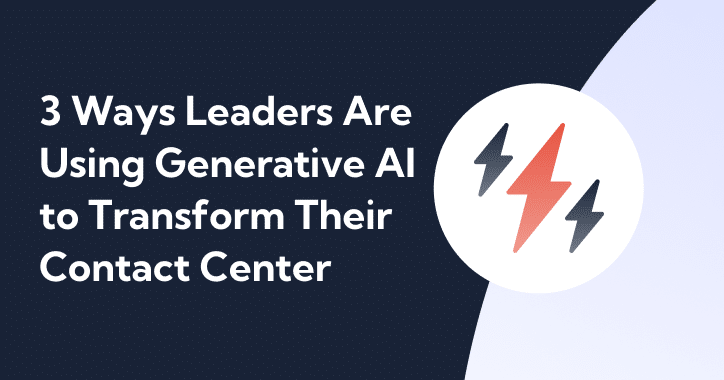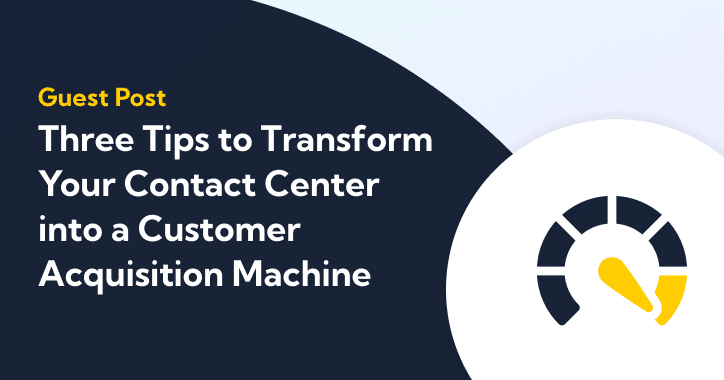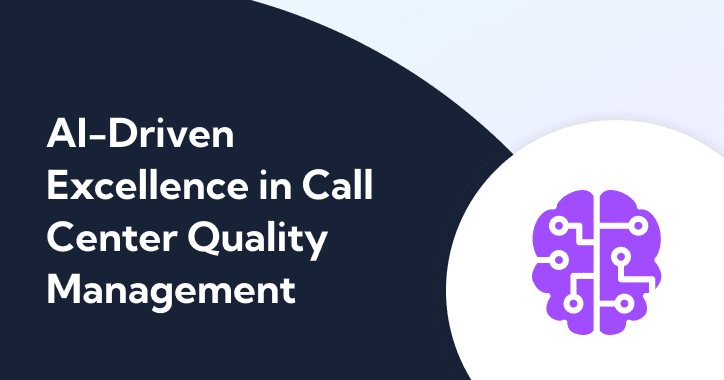The modern contact center strives to be more efficient, more productive, and more profitable than ever, so it’s no surprise that leaders turn to tech to boost performance. But not all solutions are created equal — while collaborative intelligence significantly improves an organization’s overall operations, lazy AI is frustratingly common and far less useful.
To help you avoid the time and expense of inefficient solutions, we’re continuing to highlight red flags you should dodge. In Part Two of our Lazy AI in the Contact Center series, we’re discussing agent experience.
Contact centers can’t exist without agents, and happy agents perform better. So why are many contact center solutions built on AI that hyper-focuses on agent performance, but never considers agent experience?
To ensure you positively affect agent experience when you implement new systems, keep an eye out for these pitfalls that signal lazy AI.
Lazy AI Zeroes in on Output, Ignores Engagement
However their organization measures performance, every contact center leader wants more productive, more efficient agents. But high performance simply cannot exist without high engagement.
In fact, engaged employees as a whole have substantially better work outcomes. In the contact center, agents are 3.3x more likely to feel empowered to resolve customer issues and 8.5x more likely to stay at their jobs.
Despite this widely understood fact, contact center software rarely targets engagement at all. Instead, it focuses staunchly on specific aspects of agent performance.
For example, a solution’s primary goal might be to improve customer satisfaction and compliance by enforcing script adherence. The AI may send agents alerts to stay on script during calls, track each agent’s win rate and script usage following a shift, and provide the manager with that data.
But how does that improve agent experience to keep agents engaged with their work? A whopping 42% of agent mistakes on calls result from agents being nervous or bored. A system only designed to track an agent’s every move certainly won’t resolve those issues.
More actively involved software can track each agent’s script usage in real time, create a team-wide leaderboard that updates continuously, and offer the highest-performing agent a prize at the end of the shift. This sort of gamification simultaneously drives motivation, engagement, and positive outcomes.
Although the goal may be the same, lazy AI makes the process feel oppressive for agents; gamifying the experience with proactive AI leads to better performance and simply makes work more fun.
Lazy AI Isolates Agents, Fueling Disconnection
Despite talking to people all day, agents can feel alone at work. A sense of teamwork and the ability to quickly interact with managers are vital.
It’s important for engagement and performance that agents feel supported by a network of veteran employees. In fact, 57% of agents who can reach their supervisors within a few minutes report being very satisfied (and in turn, more engaged) with their work.
Despite the importance of connection in the contact center, lazy AI often makes agents feel even more isolated. Some solutions send agents automated alerts during calls; these alerts are triggered by events like a specific type of objection and offer suggestions from a pre-set list for managing the situation.
But what happens if those canned insights don’t work out, or aren’t relevant in the first place? Lazy AI leaves agents with no recourse but to white-knuckle their way through difficult calls without any meaningful guidance.
Collaborative intelligence learns from the best reps, scales those habits to the entire team, and supports agents through every call with the guidance and insight they actually need to close more sales.
Collaborative intelligence also recognizes events like objections, but instead offers highly specific methods for overcoming them in real time. These suggestions are based on past successes. And if all else fails, collaborative solutions allow agents to reach out to managers while they’re still on the call. Agents can request live assistance without disrupting the flow of conversation.
By making it easier for agents to get the help they need right when they need it, collaborative intelligence fuels a sense of community. Lazy AI siloes agents, leaving them feeling disconnected and disengaged.
Lazy AI Deprioritizes Customization
To lazy AI, every agent is the same — they’re fed identical scripts from identical platforms with no room for personalization.
But agents aren’t all the same. They have their own communication styles and their own preferences that determine what engages them. The problem is, lazy AI focuses on key performance indicators without allowing the sort of customization that enhances agent experience.
A solution might endeavor to improve customer satisfaction and first call resolutions by testing different phrases with multiple playbook rollouts. This way, it can gather data about which playbook works best and scale it to the entire team.
While this method is theoretically effective, it fails to account for agent individuality. If an agent isn’t comfortable with the wording of a script item, they’ll likely rephrase it or skip it entirely.
Collaborative intelligence can gather data about which phrases are most effective and scale them to the entire team. At the same time, it allows each agent the latitude to adjust the script to fit their style. Intent-based voice processing means there’s no need to stick to the precise language of the script, but when agents have found that entirely different methods work better for them personally, they can make changes to their scripts. Best of all, collaborative intelligence will learn from those changes.
In addition to these functional customization options, collaborative intelligence lets agents change the look and feel of their systems by updating colors and icons to match their style. Lazy AI treats each agent like one of many, but to enhance agent experience solutions need to recognize each agent as one of a kind.
Lazy AI Fails to Address Limitations
The single largest reason for agent mistakes on calls is that they simply forget what they are supposed to say. In fact, a lapse in memory accounts for almost a quarter of agent mistakes..
Given this fact, it’s no wonder that agents are more likely to leave a job if they find the script stressful. After all, agents are only human — they can’t reasonably be expected to remember vast, complicated decks or the answers to every potential question. Still, some solutions using lazy AI don’t have the dexterity to offer up the right guidance or information in real time.
When contact center software relies on less advanced functions, like keyword triggers, it leaves agents vulnerable on calls. If a customer or agent doesn’t use precisely the right language, keyword-matching AI may not recognize a turn in conversation. This forces agents to rely on memory to provide answers or de-escalate a tense call.
Collaborative intelligence instead listens to the entire conversation and better understands nuanced interactions. When they’re confident that a solution will consistently guide them through their calls, agents can forget the stress of memorization.
Lazy AI may claim to guide agents in real time, but it’s inconsistent. This contributes to agent nerves and ultimately falls short of addressing agents’ biggest issue on calls: memory. To give agents confidence, keep them engaged with the script, and cut down on mistakes, a solution needs to offer the right prompts in real time, every time.
Curate Agent Experience with Collaborative Intelligence
Agent experience takes a backseat with lazy AI, but it’s front and center with collaborative solutions. Engaged agents perform better, so collaborative intelligence takes a holistic approach to enhancing contact center operations by targeting agent experience right along with performance.
When searching for a platform that can transform your contact center, remember to seek out features that enhance agent experience. Bear in mind these telltale signs of lazy AI; when in doubt, look for real-time functionality.
As the industry-leading Real-Time Guidance solution, Balto understands the challenges associated with building efficient, collaborative intelligence. We also know that if support doesn’t arrive in real time, then it’s arriving too late. Real-time offers immediate meaningful support, enhances agent experience, and boosts organizational performance.
For more insight into why real-time is the only real solution for modern contact centers, take a tour of Balto or schedule a demo today.






